Chiapas, located in southern Mexico, is a region with an enormous diversity of ecosystems, including mountain ranges, tropical rainforests, and coastal plains.
As a result, it is home to an array of bird species. There are over 700 species that have been identified in the area, making Chiapas one of the richest states in Mexico for birdwatching.
These birds range from the small, vibrantly colored tropical birds to enormous birds of prey. In this article, we will take a closer look at some of the birds commonly found in Chiapas, their habitats, and unique characteristics.
Join us on this journey to discover the fascinating world of birds in Chiapas.
1. Amazon Kingfisher
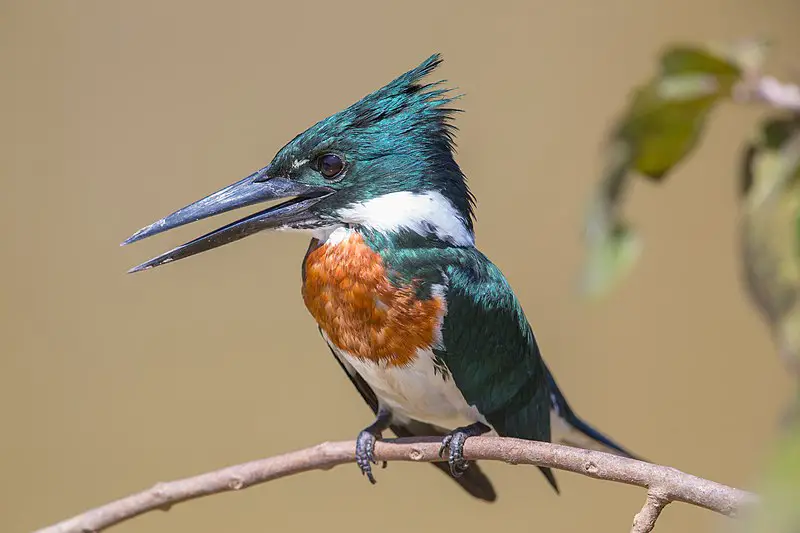
The Amazon Kingfisher is a stunning species of water kingfisher found in the lowlands of Central and South America.
It has an aqua-green head, chestnut wings with white markings, blue back and tail and yellow feet.
Its dramatic plumage makes it one of the most attractive birds in its region.
The Amazon Kingfisher can be seen perching on branches or flying close to slow moving rivers while they search for food such as fish, frogs, lizards or insects which they catch by diving into the water from above.
Despite their colorful appearance these bird are incredibly shy so it’s difficult to get too close without scaring them away.Scientific classification:
| Kingdom | Animalia |
| Phylum | Chordata |
| Class | Aves |
| Order | Coraciiformes |
| Family | Alcedinidae |
| Subfamily | Cerylinae |
| Genus | Chloroceryle |
| Species | C. amazona |
Also Featured In: Beautiful Brazilian Birds, Birds That Live in the Jungle
2. Inca Dove
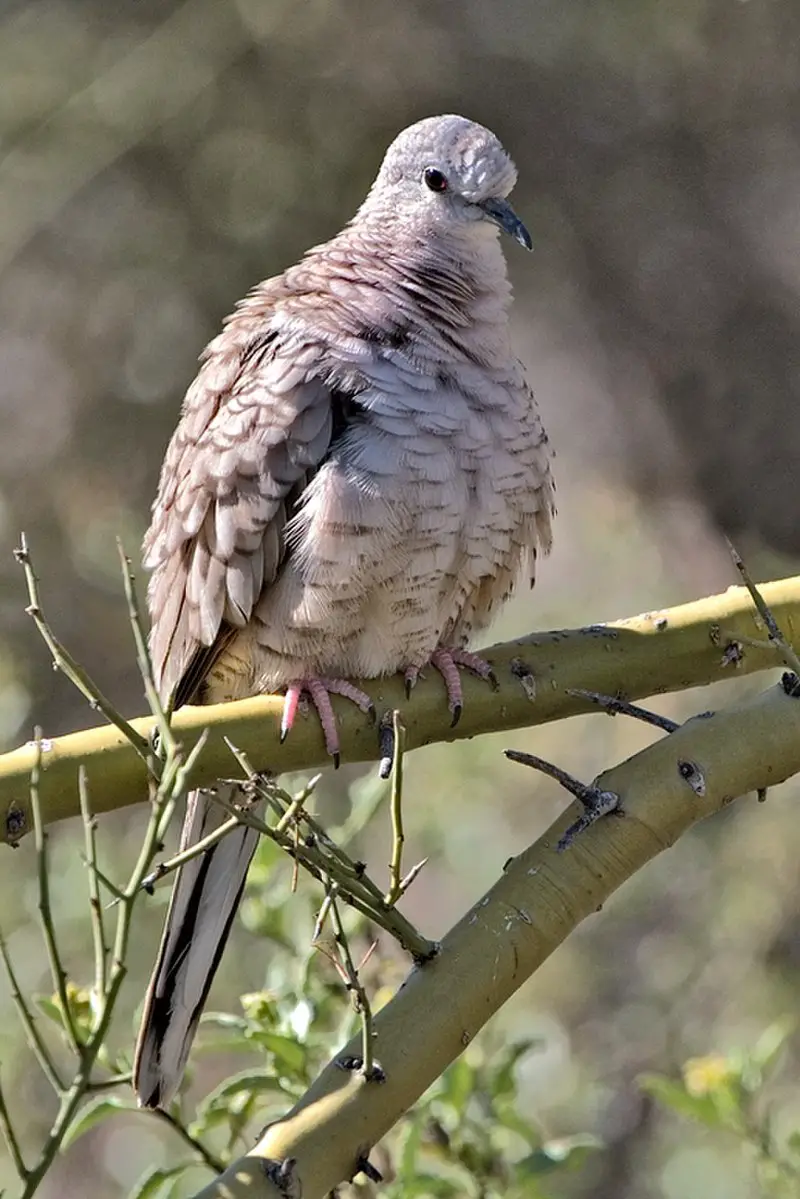
The Inca Dove is a small, slender bird found in the New World. It has an average length of 16.5–23 cm and weighs about 30-58 gm. Its wingspan measures around 28.5cm but can reach up to 32cm at max.
The body of this dove is grayish brown with feathers that are rounded off tips giving it a soft look overall.
This species was first described by French surgeon and naturalist René Lesson back in 1847 and since then have been living happily all over North America from Mexico through Texas to South Dakota, Kansas as well as parts of Arizona among others regions too.Scientific classification:
| Kingdom | Animalia |
| Phylum | Chordata |
| Class | Aves |
| Order | Columbiformes |
| Family | Columbidae |
| Genus | Columbina |
| Species | C. inca |
Also Featured In: Top Birds Found in Mexico, Birds You’ll Find in the Rio Grande Valley
3. Russet-Crowned Motmot
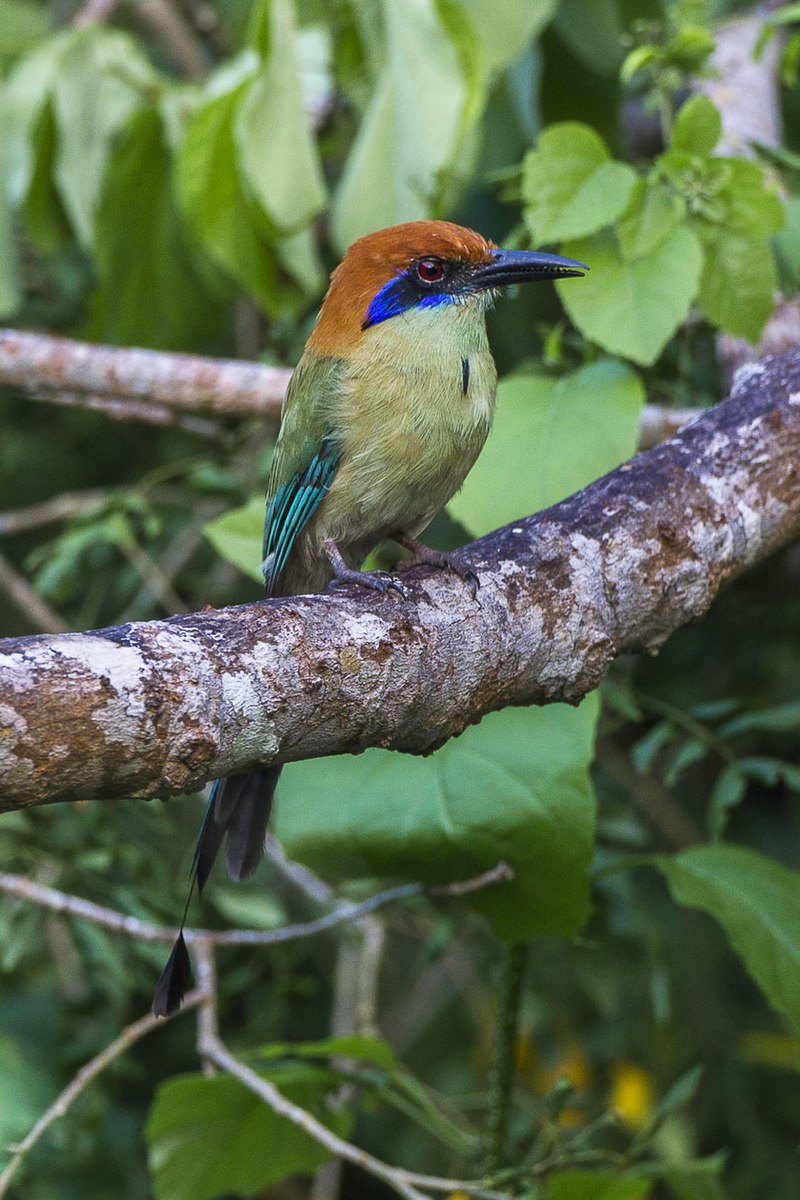
The Russet-crowned Motmot is an exotic species of bird native to north-western Mexico and central Guatemala. It is a year round resident in tropical dry broadleaf forests, scrubland and other areas with plentiful vegetation.
This type of motmots are easily identified by their reddish-brown crest on top of their heads which gives them the name ‘russet’ crowns.
These birds have also been observed displaying unique behaviors such as “bill-wagging” where they will move their bills from side to side while perched atop branches or trees.
They can be found eating insects, reptiles, amphibians, fruits and occasionally small mammals like mice or bats.
The russet crowned motmot population has declined due to deforestation but conservation efforts are helping protect this beautiful creature so that future generations may enjoy it’s majestic beauty for years to come.Scientific classification:
| Kingdom | Animalia |
| Phylum | Chordata |
| Class | Aves |
| Order | Coraciiformes |
| Family | Momotidae |
| Genus | Momotus |
| Species | M. mexicanus |
Also Featured In: Birds that Live in Morelos,
4. Ringed Kingfisher
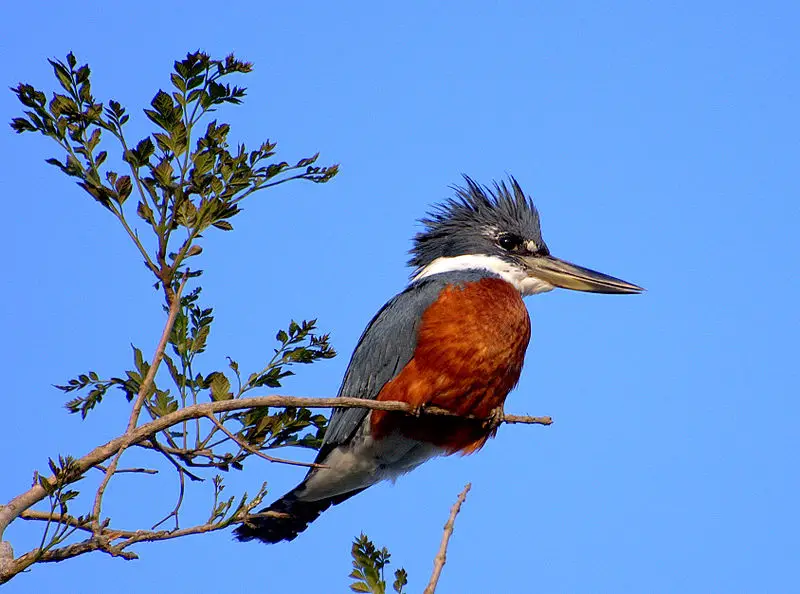
The Ringed Kingfisher is a large, vibrant bird that can be easily noticed by its loud call. It’s found in tropical regions from the lower Rio Grande Valley of southeastern Texas to Central America and even as far south as Tierra del Fuego.
This ground-dwelling species prefers to inhabit open areas near water bodies like streams, rivers and lakes which provide them with plenty of food such as fish, amphibians, crustaceans and insects.
In 1888 it was first identified by ornithologist Frank Chapman who noted its distinct ring pattern on the breast area.
The upperparts are dark blue while underneath they have white spots around their neck and belly region along with pale brown wings tipped in black stripes making this species quite unique among other kingfishers.
They may look intimidating but these birds actually play an important role for humans since they help control insect populations thus helping maintain a healthy balance within our ecosystems.Scientific classification:
| Kingdom | Animalia |
| Phylum | Chordata |
| Class | Aves |
| Order | Coraciiformes |
| Family | Alcedinidae |
| Subfamily | Cerylinae |
| Genus | Megaceryle |
| Species | M. torquata |
Also Featured In: Common Birds in Colombia, Birds that Live in Guyana
5. Groove-Billed Ani
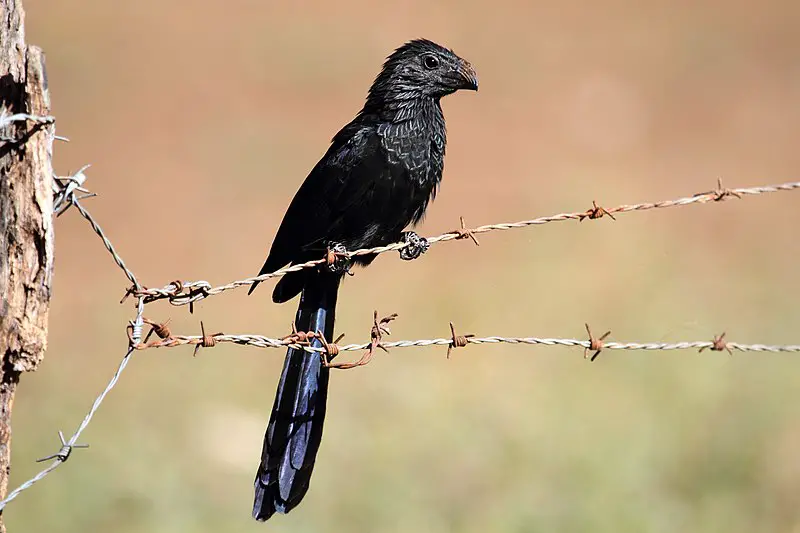
The Groove-billed ani is a tropical bird belonging to the cuckoo family. It has a long tail and large, curved beak.
This species can be found in many parts of Central America, from southern Texas to northern Colombia and Venezuela, as well as coastal Ecuador and Peru.
In some places it may retreat during colder months but overall they are considered resident birds throughout their range.
They prefer open woodlands near water sources like mangroves or swamps where there plenty of insects for them to feed on such as grasshoppers and beetles.
The beautiful coloration of this species ranges from blackish brown with orange spots on its wings that give way to bright blue feathers at the end of its tail making it quite striking.Scientific classification:
| Kingdom | Animalia |
| Phylum | Chordata |
| Class | Aves |
| Order | Cuculiformes |
| Family | Cuculidae |
| Genus | Crotophaga |
| Species | C. sulcirostris |
Also Featured In: Most Unique Birds in Peru, Birds that Live in the Grand Canyon National Park
6. Collared Trogon
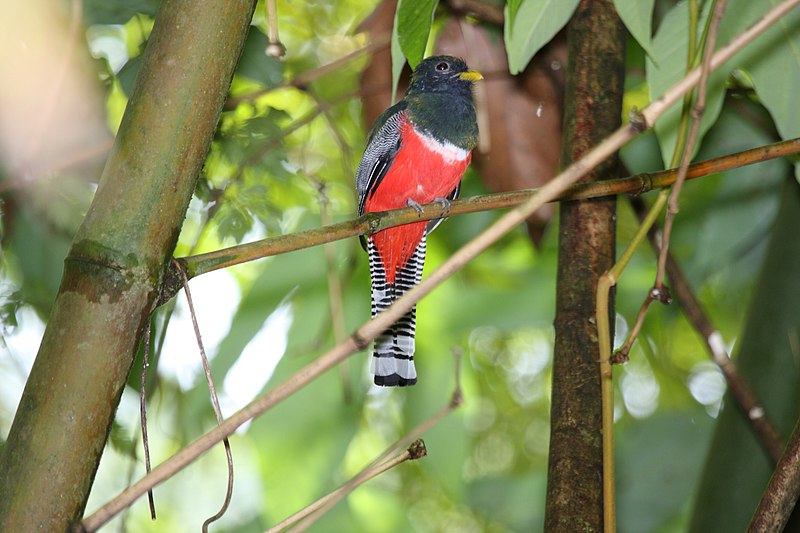
The Collared Trogon is a beautiful bird found in Mexico, Central America and northern South America. It belongs to the family of quetzals and trogons.
The International Ornithological Committee (IOC) recognizes 10 subspecies of this species, with one being called orange-bellied trogon due to its bright belly feathers.
Its plumage features colors such as iridescent greens, blues, yellows and blacks that create an attractive pattern on their wings when they take flight from branch to branch searching for food.
They primarily eat fruits but also consume insects small lizards or frogs occasionally for extra sustenance if needed.
A great majority are sedentary non migrant birds however some will travel short distances during specific periods of the year depending on where they live geographically speaking All in all these amazing creatures make a wonderful addition to any wildlife scene.Scientific classification:
| Kingdom | Animalia |
| Phylum | Chordata |
| Class | Aves |
| Order | Trogoniformes |
| Family | Trogonidae |
| Genus | Trogon |
| Species | T. collaris |
Also Featured In: Birds of Venezuela,
7. Barred Antshrike
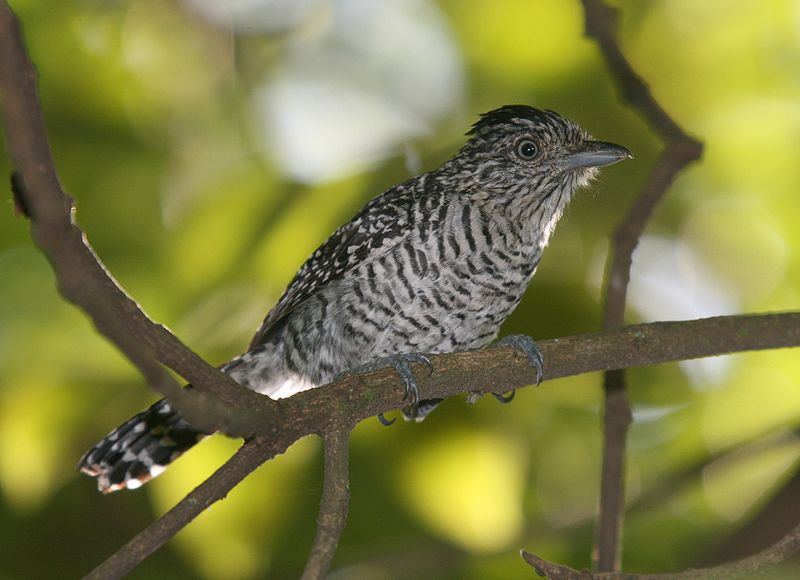
The Barred Antshrike is a beautiful bird belonging to the antbird family. It has an amazing range, being found in Mexico, Central America, Trinidad and Tobago as well as most of South America east of the Andes.
Even southern Texas has one accepted record. This small passerine can be spotted inhabiting wooded habitats that may consist of both dry and humid forests or even plantations with trees.
Its plumage consists mainly of black barring on its chestnut back along with white stripes on its wings giving it a unique look in flight.
Despite their shy nature they are quite vocal during breeding season when males sing from high perches for courtship displays; this is also when you’re likely to spot them at best.Scientific classification:
| Kingdom | Animalia |
| Phylum | Chordata |
| Class | Aves |
| Order | Passeriformes |
| Family | Thamnophilidae |
| Genus | Thamnophilus |
| Species | T. doliatus |
Also Featured In: Common Margarita Island Birds,
8. Green Kingfisher
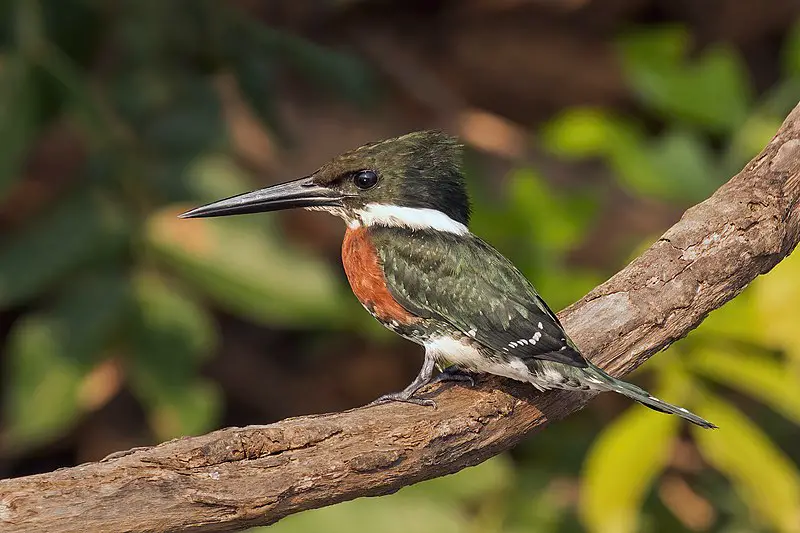
The Green Kingfisher is an incredibly vibrant bird, boasting a bright green plumage and long beak.
It can primarily be found throughout Central America, in most South American countries except Chile, as well as Texas in the United States and Trinidad & Tobago.
This species of water kingfisher belongs to subfamily Cerylinaeof family Alcedinidae which was first described by German naturalist Johann Friedrich Gmeiner back in 1788.
The Green Kingfishers are known for their active hunting habits where they perch above shallow waters looking out for prey such as small fish or crustaceans before diving down rapidly into the water with a loud splash.Scientific classification:
| Kingdom | Animalia |
| Phylum | Chordata |
| Class | Aves |
| Order | Coraciiformes |
| Family | Alcedinidae |
| Subfamily | Cerylinae |
| Genus | Chloroceryle |
| Species | C. americana |
Also Featured In: Most Common Birds Found in Chile, Green Birds in That Live in Texas
9. Resplendent Quetzal
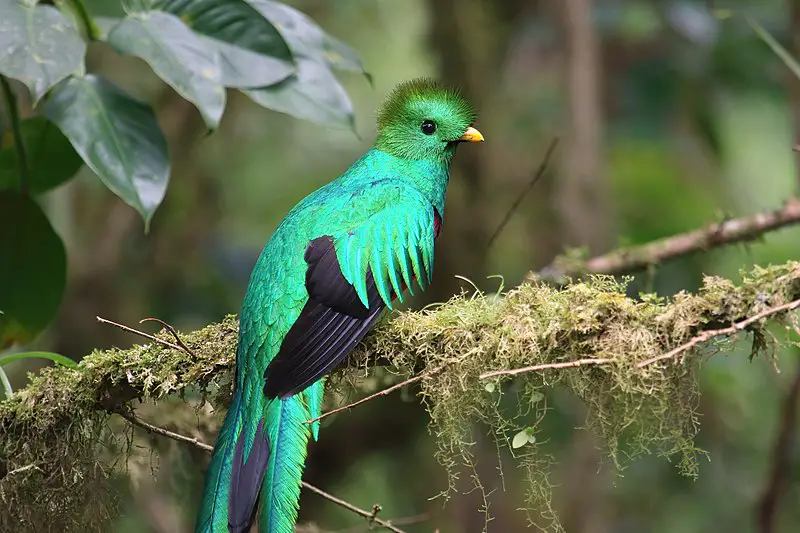
The resplendent quetzal is a beautiful and vibrant bird found in Central America. It belongs to the family Trogonidae, which includes birds like trogons and motmots.
This species of quetzal has two recognized subspecies: P. mocinno and P. costaricensis, both living in tropical forests such as montane cloud forests.
They are omnivores, typically eating fruits from various plants along with insects, lizards or eggs when available.
The male’s plumage is particularly striking with its multi-colored feathers ranging from green to blue to red that gives it its namesake “resplendence” look.
This coloration comes at a price for males because their bright colors make them more visible predators than females who have duller brown coloring instead.
Regardless of gender though all members of this species demonstrate great agility in flight due to their long tails which help stabilize them even through tight turns.Scientific classification:
| Kingdom | Animalia |
| Phylum | Chordata |
| Class | Aves |
| Order | Trogoniformes |
| Family | Trogonidae |
| Genus | Pharomachrus |
| Species | P. mocinno |
Also Featured In: Most Beautiful Birds in Guatemala, Common Latin America Birds
10. Berylline Hummingbird
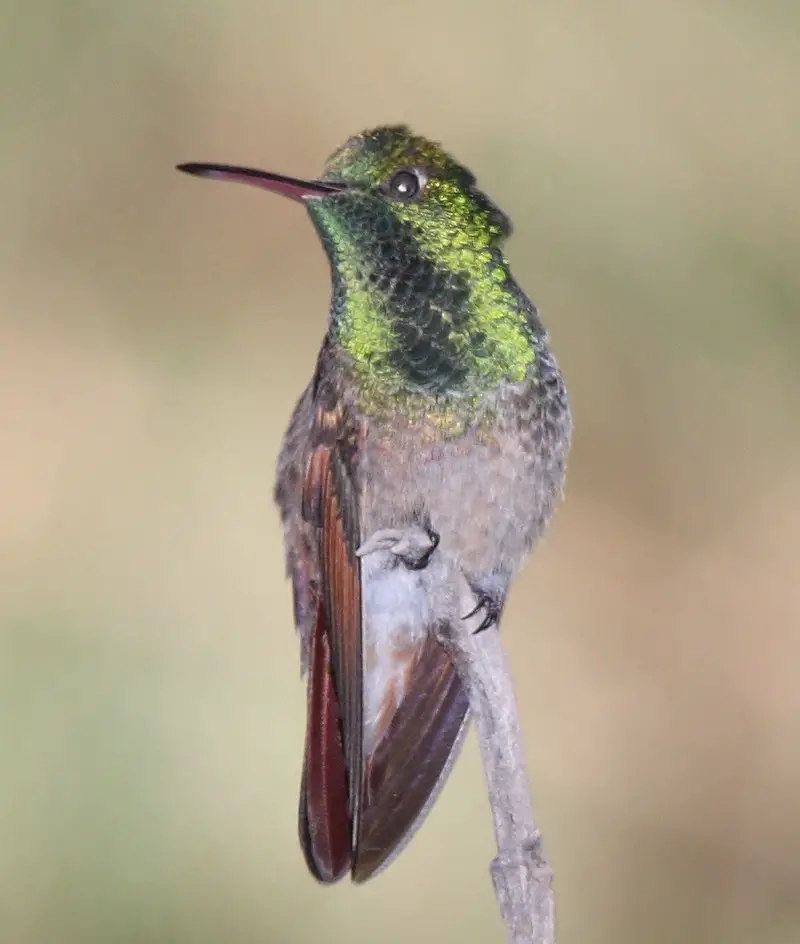
The Berylline Hummingbird is a vibrant species of hummingbird found in Central America and the United States.
It has emerald green upperparts, rufous sides and underparts, white tips to its tail feathers, as well as an iridescent purple throat patch.
These birds are highly territorial and will defend their territories against intruders with impressive aerial displays.
They feed on nectar from flowers such as bromeliads, columbines or agaves while searching for insects which they catch mid-air by hovering near foliage or flying low over meadows.
The Berylline Hummingbird is considered a Least Concern species due to its wide distribution range but it faces threats from habitat loss caused by urbanization and farming practices that reduce suitable nesting sites available for this bird.Scientific classification:
| Kingdom | Animalia |
| Phylum | Chordata |
| Class | Aves |
| Order | Apodiformes |
| Family | Trochilidae |
| Genus | Saucerottia |
| Species | S. beryllina |
Also Featured In: Most Common Birds in Michoacán, Common Birds of Mexico City
11. Azure-Crowned Hummingbird
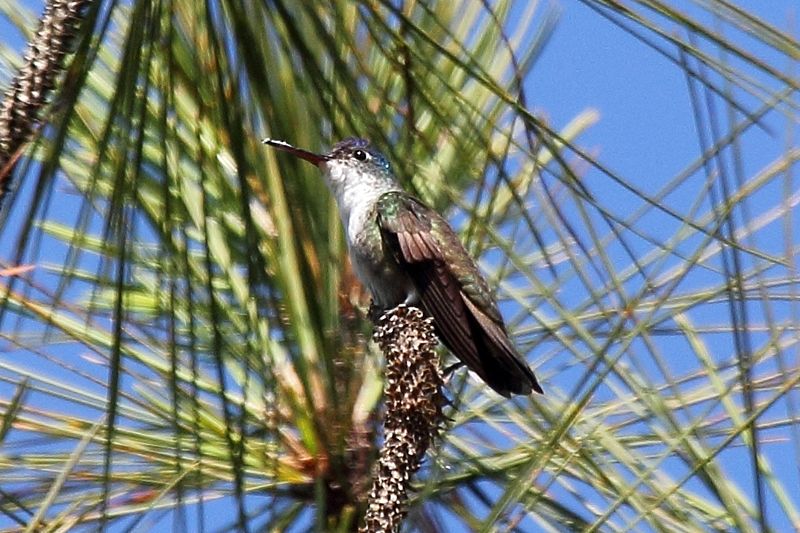
The Azure-crowned hummingbird is a species of the “emeralds” tribe Trochilini, found in Central America.
Its striking physical features include an azure crown and vibrant iridescent feathers that shimmer greenish blue when light reflects off them.
It was initially described as Ornismya cyanocephalus before being moved to its current genus Amazilia.
A molecular phylogenetic study published in 2014 showed it has close genetic ties with other emeralds such as the Green Violetear and Black-throated Mango hummers.
The bird feeds on nectar from flowers, small insects and spiders for protein, tree sap and even lizards.
This diet helps keep their metabolism high so they can stay active even during cold days or nights at higher altitudes where temperatures drop quickly after sunset.
With its beautiful colors and fascinating behavior these birds are a delight to watch wherever you may find them.Scientific classification:
| Kingdom | Animalia |
| Phylum | Chordata |
| Class | Aves |
| Order | Apodiformes |
| Family | Trochilidae |
| Genus | Saucerottia |
| Species | S. cyanocephala |
12. Slender Sheartail
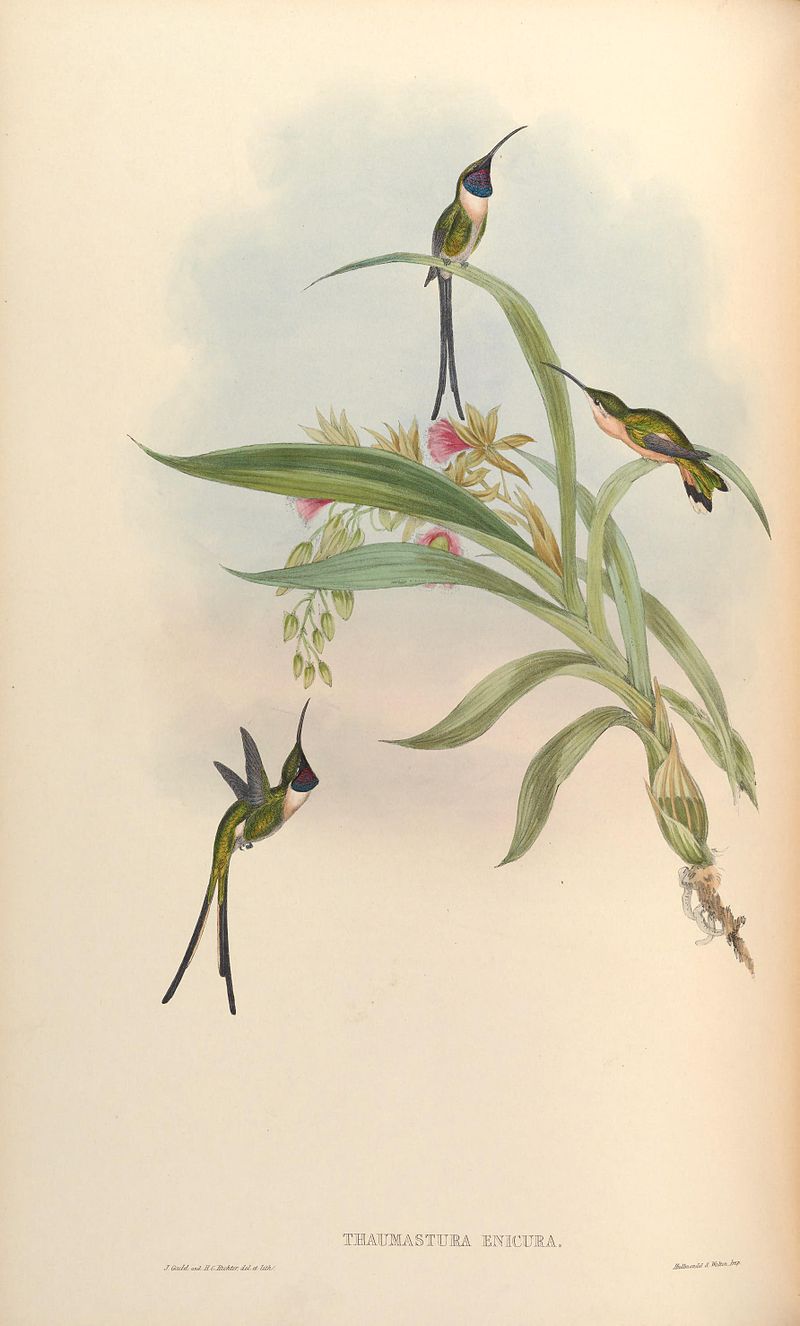
The Slender Sheartail is a species of hummingbird native to El Salvador, Guatemala, Honduras and Mexico. It belongs to the tribe Mellisugini in the subfamily Trochilinae – commonly referred to as bee-hummingbirds.
Males measure about 11-12.5 cm long and weigh 2.3g while females are slightly smaller at 10cm long with a weight of 1.8g respectively.
The slender sheartail shares its genus Doricha with another Mexican bird called the Mexican Sheartail (Doricha eliza).
Its coloration consists mainly of brown iridescent feathers on its back and wings as well as white underparts that contrast against it’s black tail which has two thin streamers or ‘shears’ giving this species their name; be sure not miss out viewing these delightful birds.Scientific classification:
| Kingdom | Animalia |
| Phylum | Chordata |
| Class | Aves |
| Order | Apodiformes |
| Family | Trochilidae |
| Genus | Doricha |
| Species | D. enicura |
13. Lineated Woodpecker
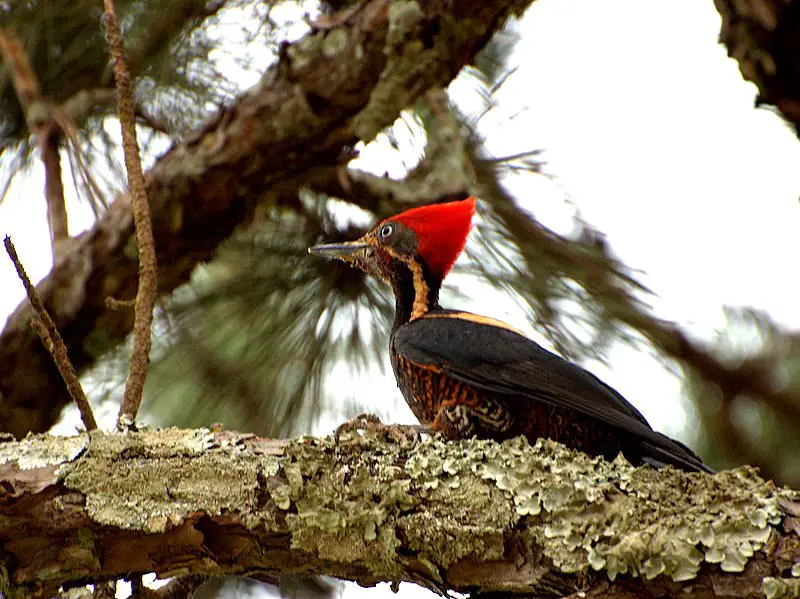
The Lineated Woodpecker is a large bird found in Mexico, Argentina and the Caribbean. It was first described by French zoologist Mathurin Jacques Brisson in 1760 with the name Le pic noir.
This species has black upperparts, wings and tail with white stripes running along its back and head; it also features red marks on its forehead as well as on both sides of its neck.
Its underparts are mostly greyish-white while its bill is yellowish-black and slightly hooked at the end.
These birds feed mainly on insects but can sometimes be seen foraging for fruits or tree sap too.
They nest inside cavities usually made from dead trees which they excavate themselves using their strong bills perfect for drilling into woody material easily.
All in all, these beautiful birds make an interesting addition to any backyard garden.Scientific classification:
| Kingdom | Animalia |
| Phylum | Chordata |
| Class | Aves |
| Order | Piciformes |
| Family | Picidae |
| Genus | Dryocopus |
| Species | D. lineatus |
Also Featured In: Birds of Bolivia, Birds that Live in Jalisco Birds
14. White-Fronted Amazon
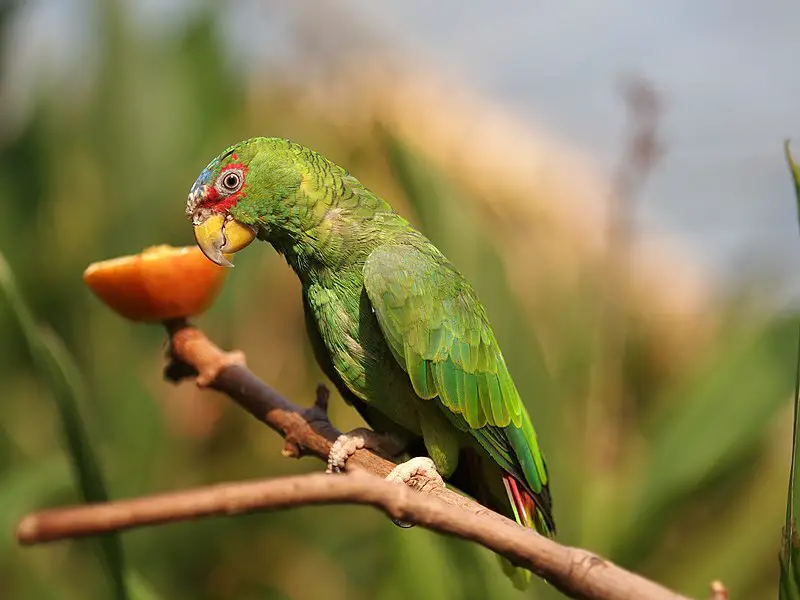
The white-fronted amazon is a Central American parrot that stands out for its bright colouring and ability to imitate around 40 different sounds.
It has an average life span of about 40 years, making it one of the longest living parrots in existence.
Despite being the smallest species among large parrots, measuring 25cm long, this bird still possesses strong vocal chords which can be heard from great distances.
They have beautiful yellow heads with distinctive white patches on their forehead and grey feathers covering their wings and tail.
These birds are very social animals who live in pairs or family groups within tropical rainforests and wetlands where they feed mostly on seeds found in trees such as palms.Scientific classification:
| Kingdom | Animalia |
| Phylum | Chordata |
| Class | Aves |
| Order | Psittaciformes |
| Family | Psittacidae |
| Genus | Amazona |
| Species | A. albifrons |
Also Featured In: Birds of Honduras,
15. White-Throated Magpie-Jay
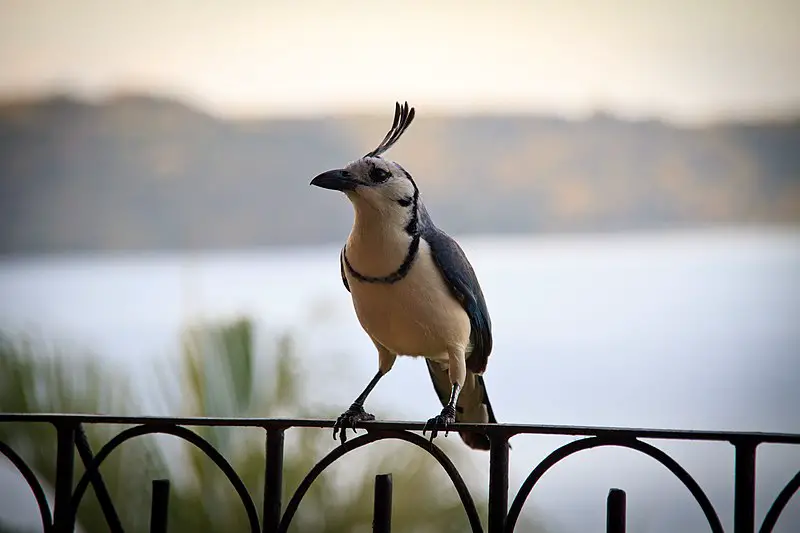
The White-throated Magpie-Jay is a large, gregarious bird native to Central America. It has an unmistakable white throat and black head with striking blue wings and tail feathers.
Its range extends from Jalisco, Mexico to Guanacaste in Costa Rica where it can be found inhabiting Pacific-slope thorn forest habitats.
This species of magpie was formally described by the English naturalist William John Swainson in 1827 and since then have become known for their noisey behavior which often includes mobbing any intruders into their territory.
They travel in flocks making them easy to spot but difficult for those who wish to avoid attention.Scientific classification:
| Kingdom | Animalia |
| Phylum | Chordata |
| Class | Aves |
| Order | Passeriformes |
| Family | Corvidae |
| Genus | Calocitta |
| Species | C. formosa |
Also Featured In: Colorful Birds of Nicaragua,
16. Rufous-Capped Warbler
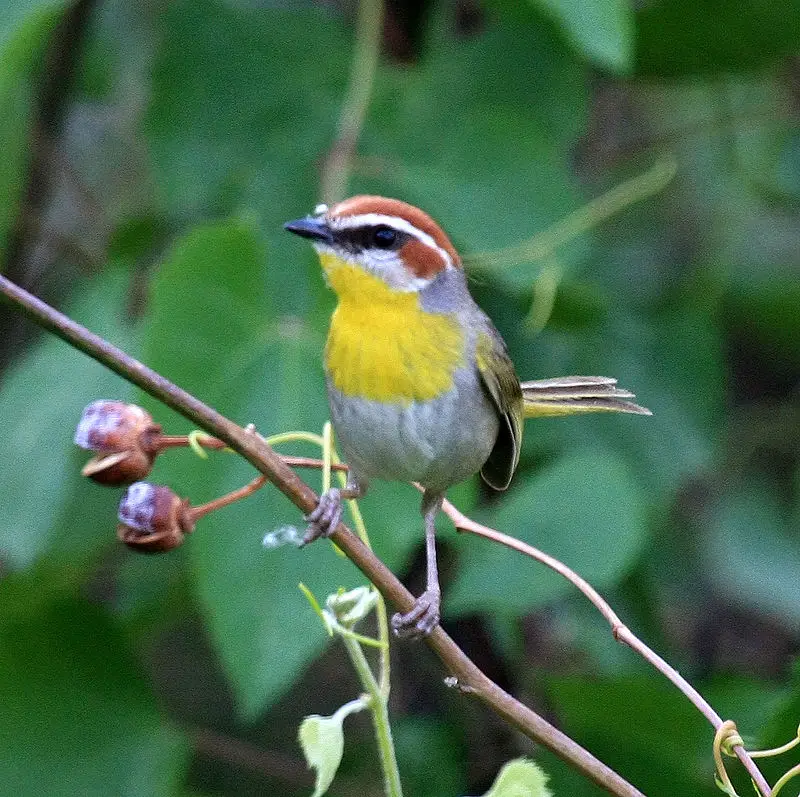
The Rufous-capped Warbler is a small New World warbler found mainly in Mexico and Guatemala.
It has distinctive chestnut-brown cap of feathers atop its head, along with olive green upperparts and yellowish underparts.
Subspecies living further south are sometimes considered as the Chestnut-Capped Warbler instead.
They usually reach 12.7 cm (5in) in length, making them one of the smaller species within their family.
As insectivores they feed on insects such as caterpillars but will also consume fruits when available and breed from March to June depending on location; nesting either close to or above ground using mosses, lichens, grasses, spider webs etc for construction material.Scientific classification:
| Kingdom | Animalia |
| Phylum | Chordata |
| Class | Aves |
| Order | Passeriformes |
| Family | Parulidae |
| Genus | Basileuterus |
| Species | B. rufifrons |
Also Featured In: Most Common Birds of Nuevo Leon,
17. Bare-Throated Tiger Heron
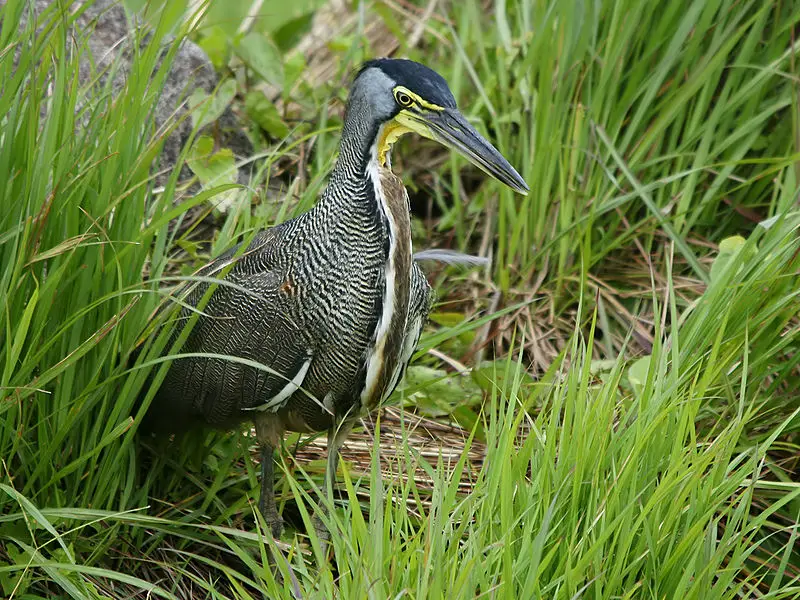
The Bare-throated Tiger Heron is an impressive wading bird belonging to the heron family, Ardeidae.
It has a length of 80 cm and weighs 1,200 grams. Found from Mexico to northwestern Colombia with one recorded sighting from the United States in Texas, it prefers more open habitats such as river and lake banks than other Tigrisoma herons.
Its plumage is blackish above with white spots on its back while its lower parts are chestnut brown or rufous in coloration.
The head and throat have bare yellow skin that can turn bright red when alarmed or during courtship displays.
Additionally, these birds feed mainly on fish but also eat amphibians, reptiles and aquatic insects which they capture by standing still before suddenly snatching them up.Scientific classification:
| Kingdom | Animalia |
| Phylum | Chordata |
| Class | Aves |
| Order | Pelecaniformes |
| Family | Ardeidae |
| Genus | Tigrisoma |
| Species | T. mexicanum |
Also Featured In: Most Common Birds You’ll Find in Quintana Roo,
18. Golden-Fronted Woodpecker
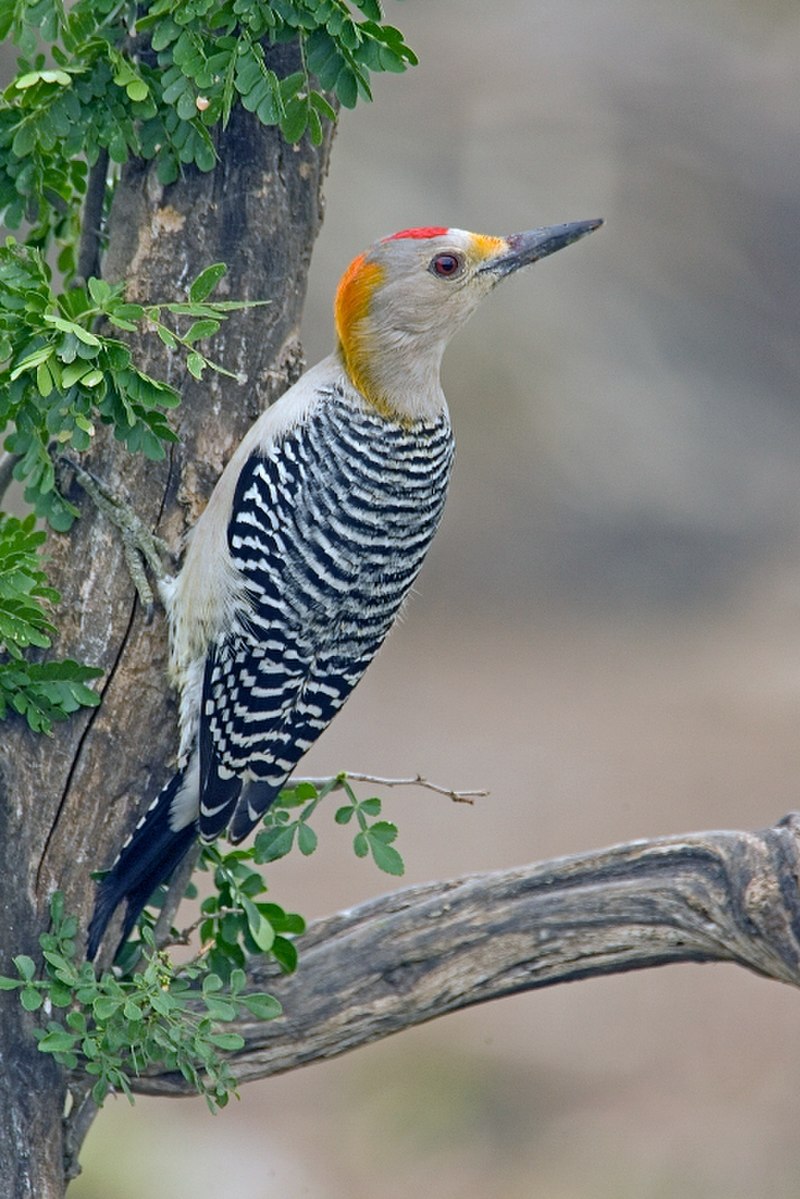
The golden-fronted woodpecker is an attractive species that inhabits mesquite, riparian woodlands and tropical rainforests across the southern United States, Mexico, Belize Guatemala El Salvador Honduras and northern Nicaragua.
It has a unique appearance with its yellow forehead patch contrasting against its grey back feathers.
These birds eat insects as well as fruits of many trees including cactus fruit in some areas.
They are known to make nests in cavities they excavate from dead or dying trees or utility poles which helps disperse essential nutrients into the ecosystem.
Their loud calls can be heard during breeding season providing bird watchers with a memorable experience.Scientific classification:
| Kingdom | Animalia |
| Phylum | Chordata |
| Class | Aves |
| Order | Piciformes |
| Family | Picidae |
| Genus | Melanerpes |
| Species | M. aurifrons |
Also Featured In: El Salvador Birds, Native Birds in Lower Rio Grande Valley
19. Band-Backed Wren
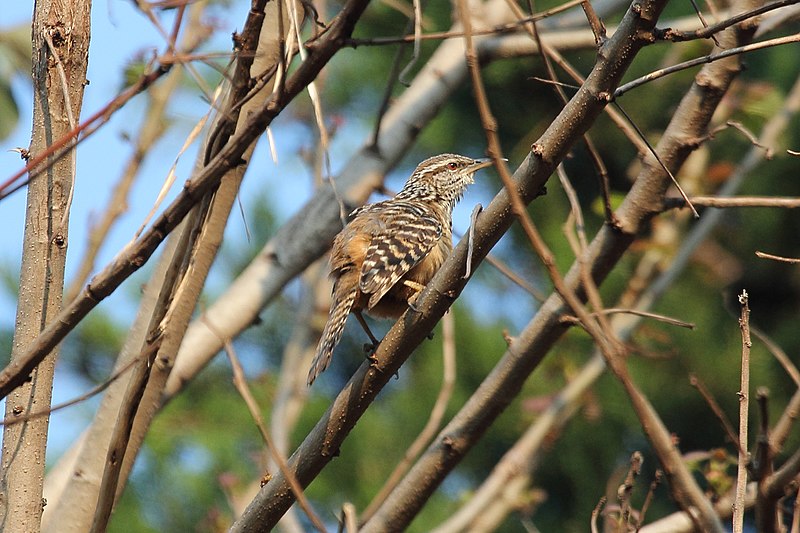
The Band-backed Wren is a small songbird of the wren family, found in five disjunct areas from south-central Gulf Coast Mexico to northwestern Ecuador.
This species is a resident breeding bird that typically inhabits tropical forests and woodlands near rivers.
It has two black stripes on its back, the namesake “band,” separating brown dorsal plumage with white spots along its sides; their chest color can vary from greyish to buffy yellow depending on location.
Its diet consists mostly of insects and other invertebrates, as well as some fruits when available.
The male usually sings during dawn and dusk hours while perched atop branches or vines in order to attract mates for reproduction purposes which typically occurs between August – March throughout Central America and South America.Scientific classification:
| Kingdom | Animalia |
| Phylum | Chordata |
| Class | Aves |
| Order | Passeriformes |
| Family | Troglodytidae |
| Genus | Campylorhynchus |
| Species | C. zonatus |
20. Social Flycatcher
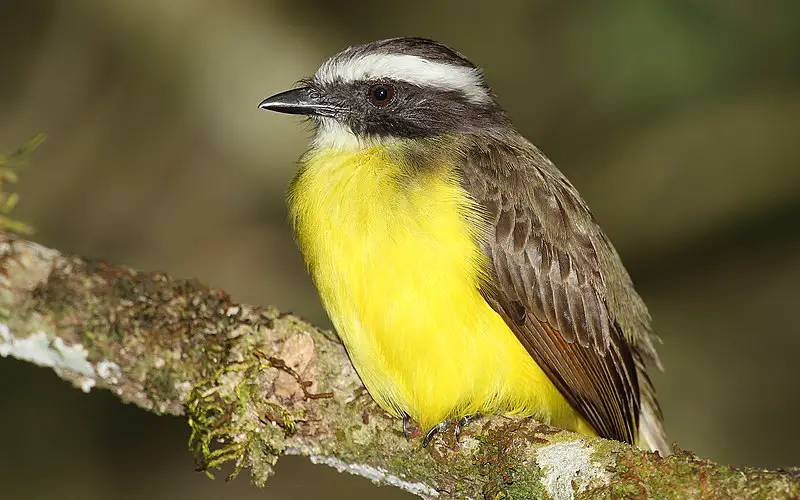
The Social Flycatcher is a medium-sized passerine bird from the Americas, belonging to the large tyrant flycatcher family.
It has often been split into two species – Myiozetetes texensis and Myiozetetes similis proper – due to its distinct range across Costa Rica northwards to Mexico and southward towards South America respectively.
This bird sports dark grey upperparts combined with white underparts, along with a vermilion crown on its head.
It also possesses an upright posture when perched which makes it easily recognizable in comparison with other birds of similar size within its habitat.
The social flycatcher feeds mainly on insects but can sometimes supplement these meals by eating fruits as well.Scientific classification:
| Kingdom | Animalia |
| Phylum | Chordata |
| Class | Aves |
| Order | Passeriformes |
| Family | Tyrannidae |
| Genus | Myiozetetes |
| Species | M. similis |
Also Featured In: Costa Rica Birds,
21. Blue-Black Grassquit
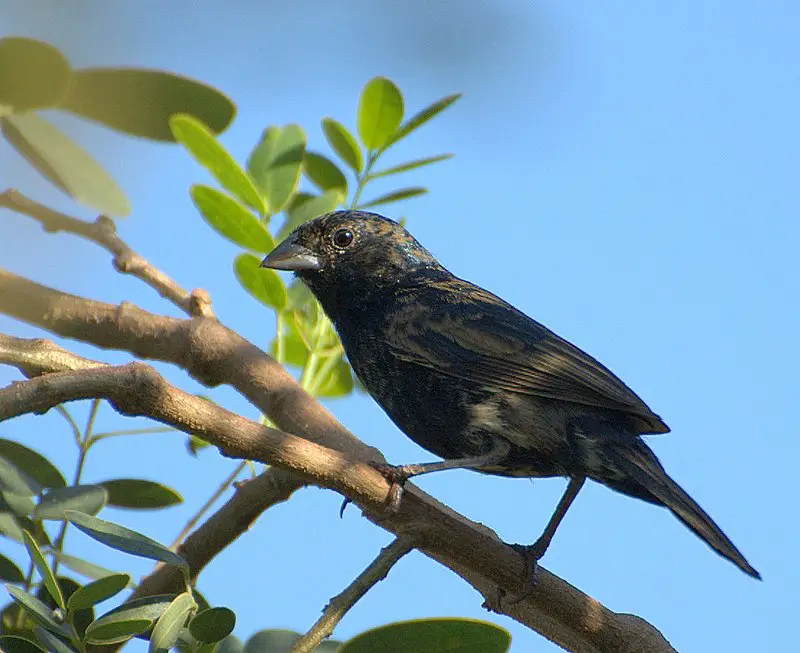
The Blue-black Grassquit is a small and vibrant bird belonging to the tanager family, Thraupidae.
It has an extremely wide range of distribution stretching from southern Mexico all the way through Central America and South America as far south as northern Chile, Argentina and Paraguay.
The male of this species features glossy blue-black feathers with yellowish primaries whereas females are less brightly coloured having predominantly greyish brown plumage.
They feed on insects such as ants, grasshoppers and beetles along with some grains they find in their habitats which include open woodlands near water sources or marshes.
These birds build nests made out of leaves lined with soft material like hair or wool at low level vegetation often close to water bodies where they can raise clutches up to two times during breeding seasons depending upon weather conditions around them.Scientific classification:
| Kingdom | Animalia |
| Phylum | Chordata |
| Class | Aves |
| Order | Passeriformes |
| Family | Thraupidae |
| Genus | Volatinia Reichenbach, 1850 |
| Species | V. jacarina |
Also Featured In: Trinidad and Tobago birds,
22. Thicket Tinamou
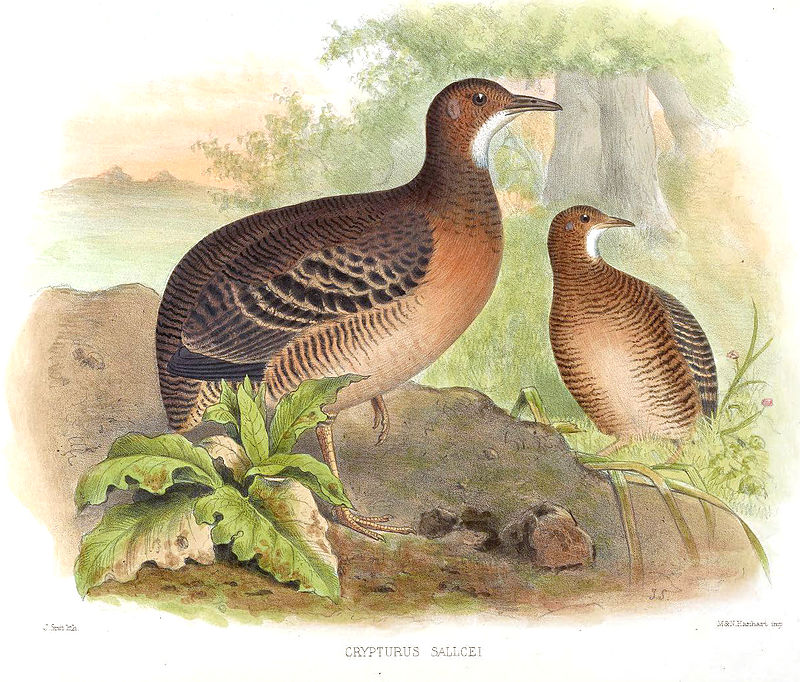
The Thicket tinamou is a type of bird found in moist forests of Central Mexico. It belongs to the family Tinamidae and is classified as a ratite, which are flightless birds that evolved from prehistoric flying species.
Despite its lack of strong flying abilities, this small brownish-grey bird can fly short distances and usually hops around on the ground instead.
Their diet consists mainly of fruits, seeds, insects and other invertebrates they find while foraging through vegetation or even grazing at times during dry season when food sources become scarce.
These solitary birds typically form pairs only during mating season where both parents work together to incubate eggs until hatchlings emerge into the world.Scientific classification:
| Kingdom | Animalia |
| Phylum | Chordata |
| Class | Aves |
| Infraclass | Palaeognathae |
| Order | Tinamiformes |
| Family | Tinamidae |
| Genus | Crypturellus |
| Species | C. cinnamomeus |
Also Featured In: Belize Birds,
23. Rusty Sparrow
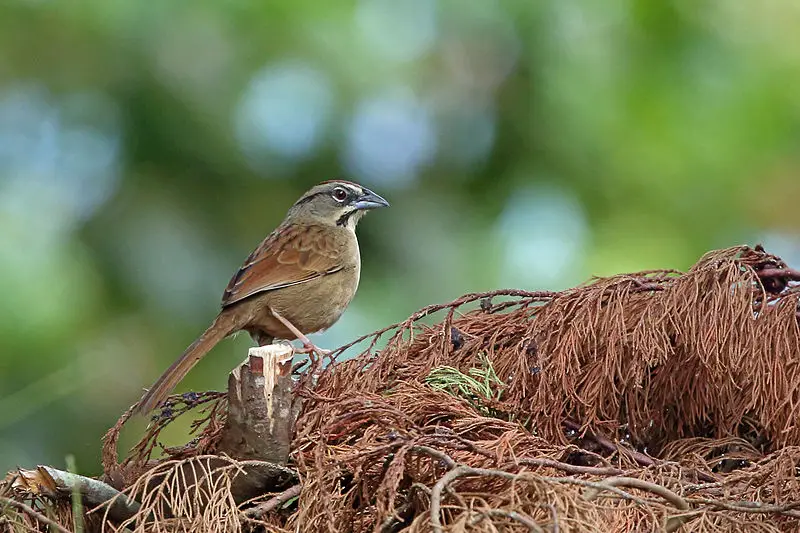
The Rusty Sparrow is a beautiful species of bird found in Central America, from Belize to Nicaragua.
It inhabits subtropical or tropical dry forests, moist montane forests and high-altitude shrublands.
Its plumage is brownish gray with rusty margins on the feathers that give it its distinctive name.
The male has an eye ring and moustache stripe which are both white while females have only one whitish streak above their eyes but lack other distinguishing features.
These birds feed mostly on insects such as beetles and ants by foraging among tree foliage or hunting them at ground level.
They also consume small fruits like figs which provide essential moisture during dry periods when there’s little water available for drinking purposes.
Despite its attractive coloring and interesting behavior, this species faces habitat loss due to deforestation activities as well as predation by larger animals so conservation efforts should be made to ensure these wonderful creatures don’t become extinct in our lifetime.Scientific classification:
| Kingdom | Animalia |
| Phylum | Chordata |
| Class | Aves |
| Order | Passeriformes |
| Family | Passerellidae |
| Genus | Aimophila |
| Species | A. rufescens |
24. White-Tipped Dove
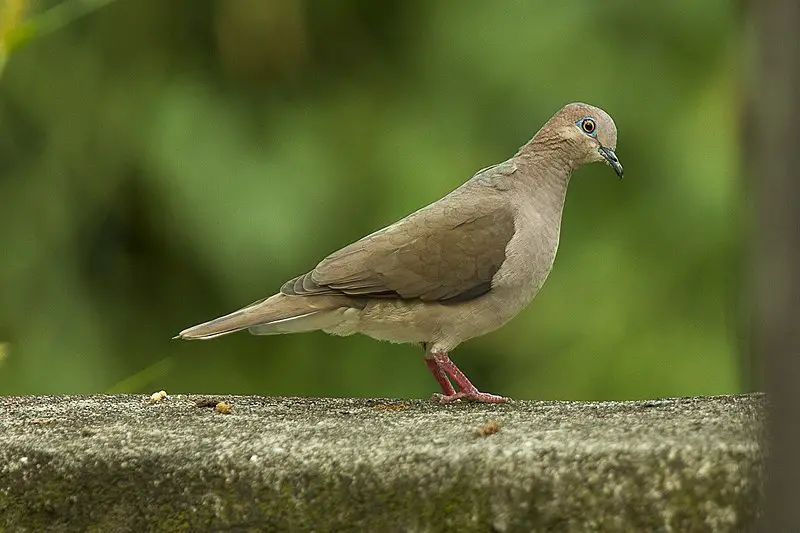
The White-tipped Dove is a majestic bird found in tropical areas of the New World, from southern Texas and Mexico all the way to western Peru and Argentina.
It carries with it an interesting scientific name: Leptotila verreauxi, named after French naturalists Jules and Edouard Verraux.
This species also breeds on offshore islands along northern South America, including Trinidad.
It has distinctive white tips on its wings which makes them easily identifiable while they are flying as well as when perched.
They have grayish brown feathers overall that helps camouflage them amongst trees or foliage making them difficult to spot otherwise.
The males tend to be slightly larger than females but other than that there isn’t much difference between their appearance aside from courtship rituals where both sexes will bow together for recognition before mating season starts.Scientific classification:
| Kingdom | Animalia |
| Phylum | Chordata |
| Class | Aves |
| Order | Columbiformes |
| Family | Columbidae |
| Genus | Leptotila |
| Species | L. verreauxi |
Also Featured In: Doves Birds, Birds You’ll Find in South Texas
25. Bat Falcon
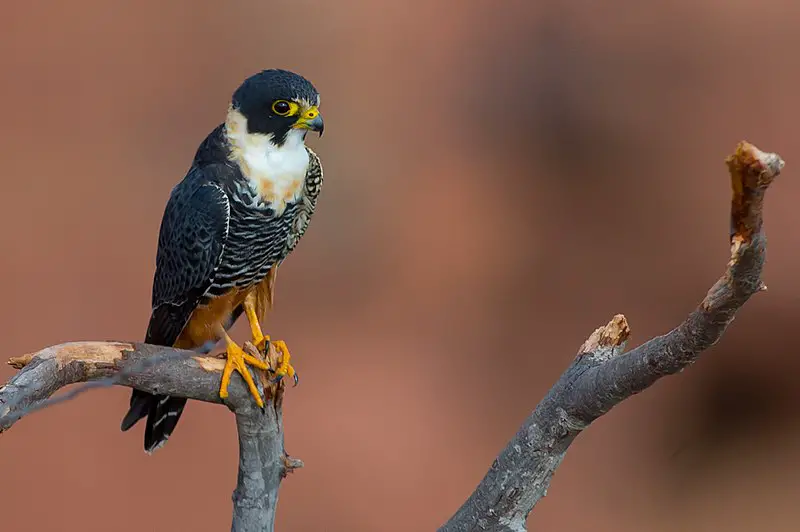
The Bat Falcon is a small falcon found in Mexico, Central and South America, as well as Trinidad. It was previously known as Falco albigularis but has since been renamed to its current name.
This bird of prey looks similar to the Orang-utan with its brownish-gray plumage and bright blue cere on top of their beaks. They are generally around 9 inches long with a wingspan reaching up to 20 inches across.
The Bat Falcons prefer open savanna or woodland habitats where they can hunt for insects or small birds during the day.
These birds rely heavily on flying insect populations which makes them vulnerable when these numbers drop due too environmental changes such climate change making it important that we protect this species from further endangerment by preserving suitable habitat types so they can continue living there happily.Scientific classification:
| Kingdom | Animalia |
| Phylum | Chordata |
| Class | Aves |
| Order | Falconiformes |
| Family | Falconidae |
| Genus | Falco |
| Species | F. rufigularis |
Also Featured In: Falcons Species, Puerto Vallarta Birds You Should Know
26. Mottled Owl
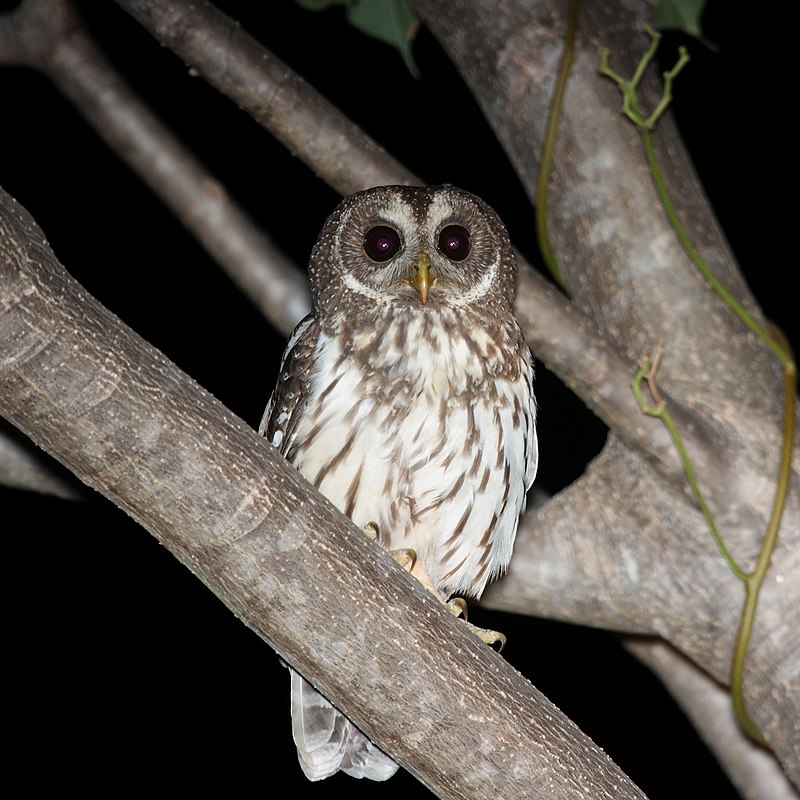
The Mottled Owl is a medium-sized owl native to Central and South America, ranging from Mexico to Brazil and Argentina.
It has mottled brown feathers on its head and back, with whitish underparts marked by vertical bars on the chest and throat.
Its eyes are dark in colouration, while its round head lacks ear tufts of any kind. These owls tend to be territorial creatures inhabiting dry forests as well as jungles at altitudes up to 2,500m (8200ft).
They feed mainly on small mammals such as mice or bats but also take birds if given an opportunity.
The female lays two eggs per clutch which she incubates for around 28 days before they hatch. In terms of conservation status it’s listed as ‘least concern’ due largely in part to their wide range across much of Latin America.Scientific classification:
| Kingdom | Animalia |
| Phylum | Chordata |
| Class | Aves |
| Order | Strigiformes |
| Family | Strigidae |
| Genus | Strix |
| Species | S. virgata |
Also Featured In: Owls Species,
27. Collared Aracari
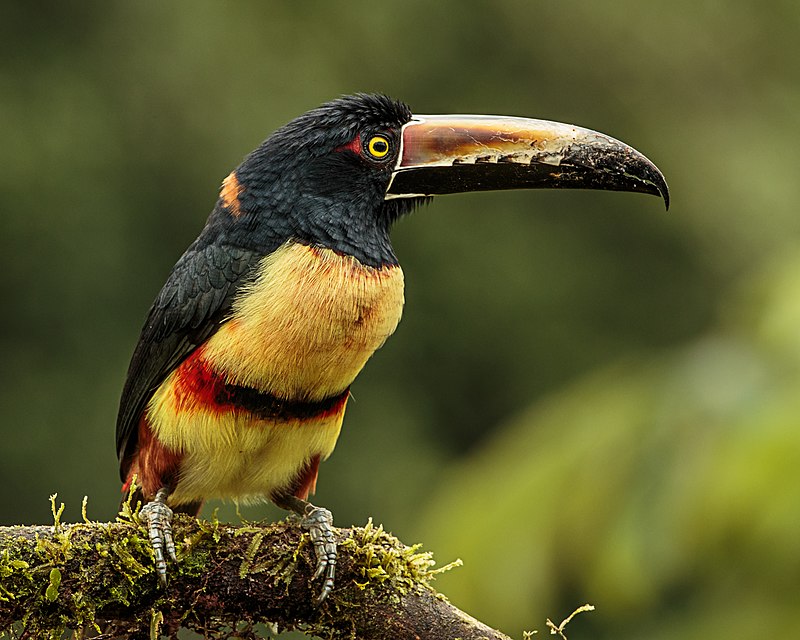
The Collared Aracari, from the toucan family, can be found in various countries from Mexico to Venezuela. Described by the Spanish naturalist Francisco Hernández in the 16th century, this beautiful bird has a colorful collar around its neck.
Unlike other toucans, Collared Aracaris don’t have a large bill, and their diet consists of a mix of fruits, insects, and small animals.
They are social creatures and can be seen in pairs or small groups during the day. These birds make their homes in tree cavities and use their beaks to create a small entrance hole.
They are not considered endangered, but their habitats are under threat due to deforestation. The Collard Aracari is an essential part of the forest ecosystem and deserves our protection.Scientific classification:
| Kingdom | Animalia |
| Phylum | Chordata |
| Class | Aves |
| Order | Piciformes |
| Family | Ramphastidae |
| Genus | Pteroglossus |
| Species | P. torquatus |
Also Featured In: Rainforest Birds You Should Know,
28. Chachalacas
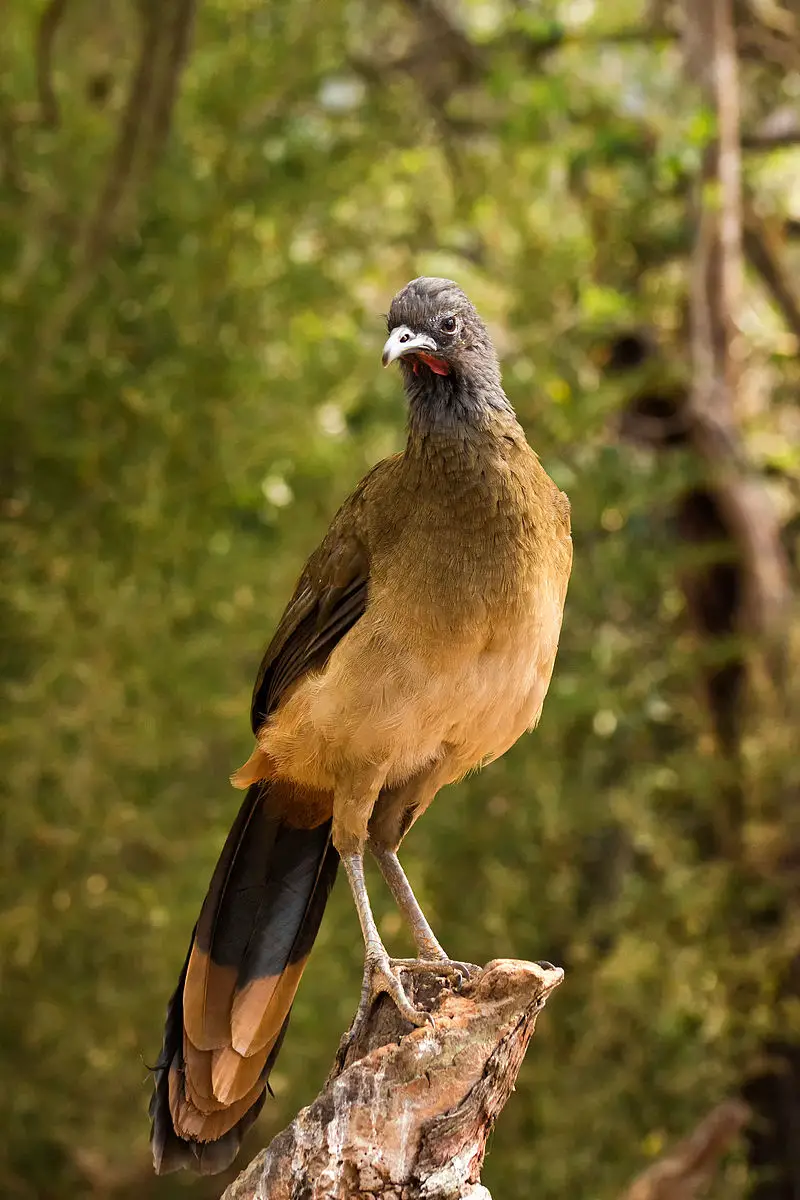
Chachalacas are small-sized galliform birds that are commonly found in wooded habitats across Central and South America, Mexico, and the southern United States, particularly Texas.
Despite being social birds, they are often known for their loud and noisy behavior. Chachalacas have managed to remain fairly common in areas near human settlements due to their small size, which makes them less desirable to hunters.
These birds are not harmful and are not considered dangerous to humans. However, as agricultural pests, chachalacas can cause some problems.Scientific classification:
| Kingdom | Animalia |
| Phylum | Chordata |
| Class | Aves |
| Order | Galliformes |
| Family | Cracidae |
| Subfamily | Cracinae |
| Genus | Ortalis Merrem, 1786 |
29. Red-Billed Pigeon
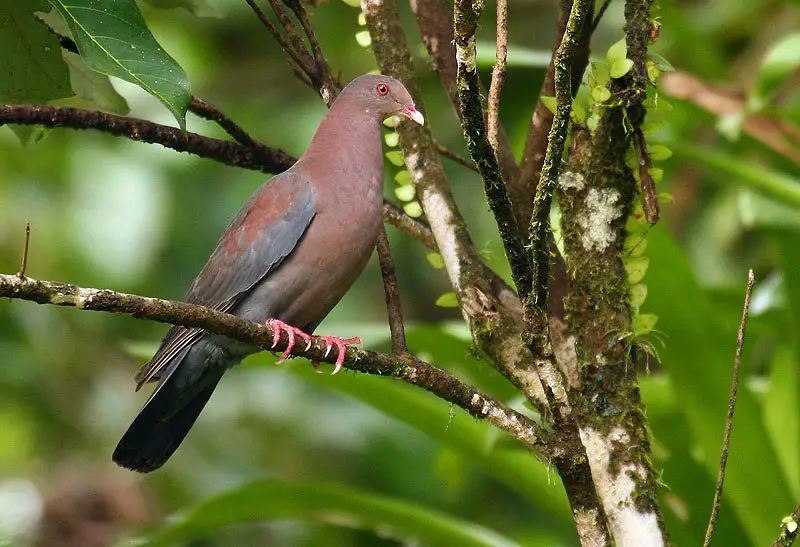
The Red-billed pigeon is a sturdy, large bird that inhabits southern Texas in the United States to the coasts and lowlands of Central America.
This species belongs to a clade of Patagioenas that typically lack iridescent display plumage.
Red-billed pigeons are commonly found in wooded areas, where they gather in flocks to feed on fruit and grains.
They are also known for their distinct cooing call, which is often heard echoing through the forest canopies.
Although not currently listed as threatened, habitat destruction and hunting pose a significant threat to the Red-billed pigeon population.
Conservation efforts could help to protect this valuable bird species for future generations to appreciate.Scientific classification:
| Kingdom | Animalia |
| Phylum | Chordata |
| Class | Aves |
| Order | Columbiformes |
| Family | Columbidae |
| Genus | Patagioenas |
| Species | P. flavirostris |
Also Featured In: Most Common Oaxaca Birds, Birds that Live in Tabasco
30. Ivory-Billed Woodcreeper
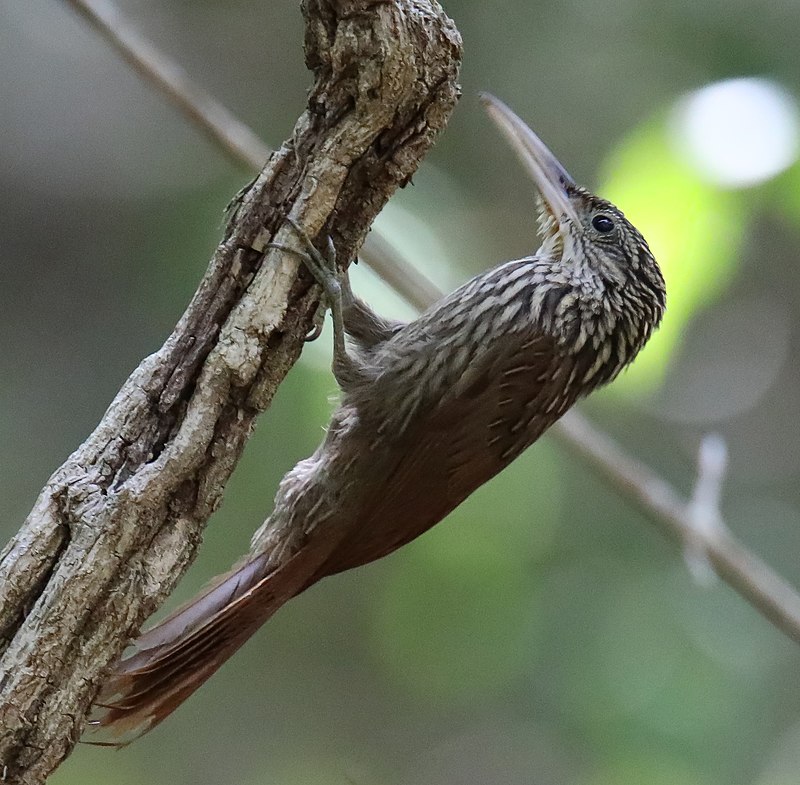
The ivory-billed woodcreeper is a noteworthy bird species found in tropical forests across Central America, including Belize, Costa Rica, El Salvador, Guatemala, Honduras, Mexico, and Nicaragua.
As a member of the Furnariidae family and the Dendrocolaptinae subfamily, this perching bird is characterized by its large size and commonality within its habitat.
Despite its unique features, there is limited information about the habits and behaviors of the ivory-billed woodcreeper.
These birds are predominantly found in dry and humid woodland areas, where they play a vital role in the forest’s ecosystem.
They are an essential component of the food chain and are preyed upon by larger birds of prey.
Overall, this bird species remains a mysterious but essential part of the Central American ecosystem.Scientific classification:
| Kingdom | Animalia |
| Phylum | Chordata |
| Class | Aves |
| Order | Passeriformes |
| Family | Furnariidae |
| Genus | Xiphorhynchus |
| Species | X. flavigaster |
31. Crested Guan
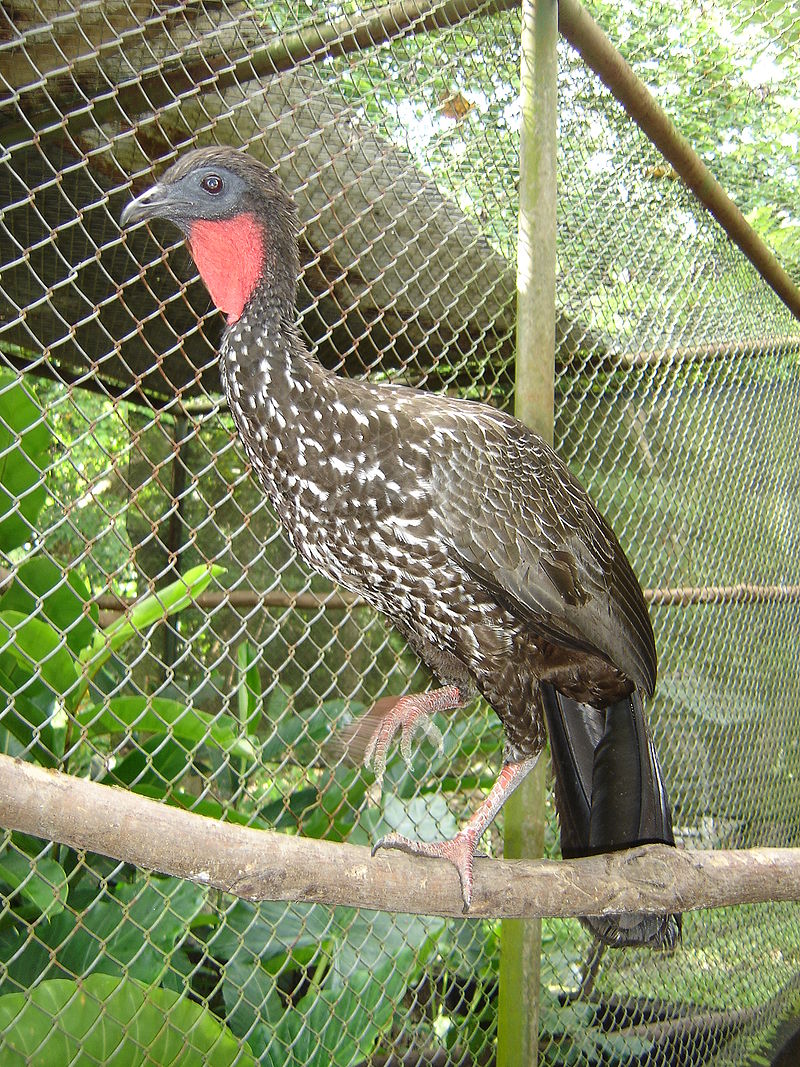
The Crested Guan bird belongs to the Cracidae family and is related to the Megapodiidae or mound builders.
The bird is primarily found in lowland forests in the Neotropics, ranging from southern Mexico to southern Venezuela.
It has a mainly dark plumage, and males and females look similar in appearance. The Crested Guan is considered an ancient bird and features a distinct, crested head.
Its diet consists of fruit and insects. Sadly, the bird is at risk of being threatened by habitat destruction and hunting.
Conservation efforts are crucial to ensure the survival of this unique bird species.Scientific classification:
| Kingdom | Animalia |
| Phylum | Chordata |
| Class | Aves |
| Order | Galliformes |
| Family | Cracidae |
| Genus | Penelope |
| Species | P. purpurascens |
32. Northern Bentbill
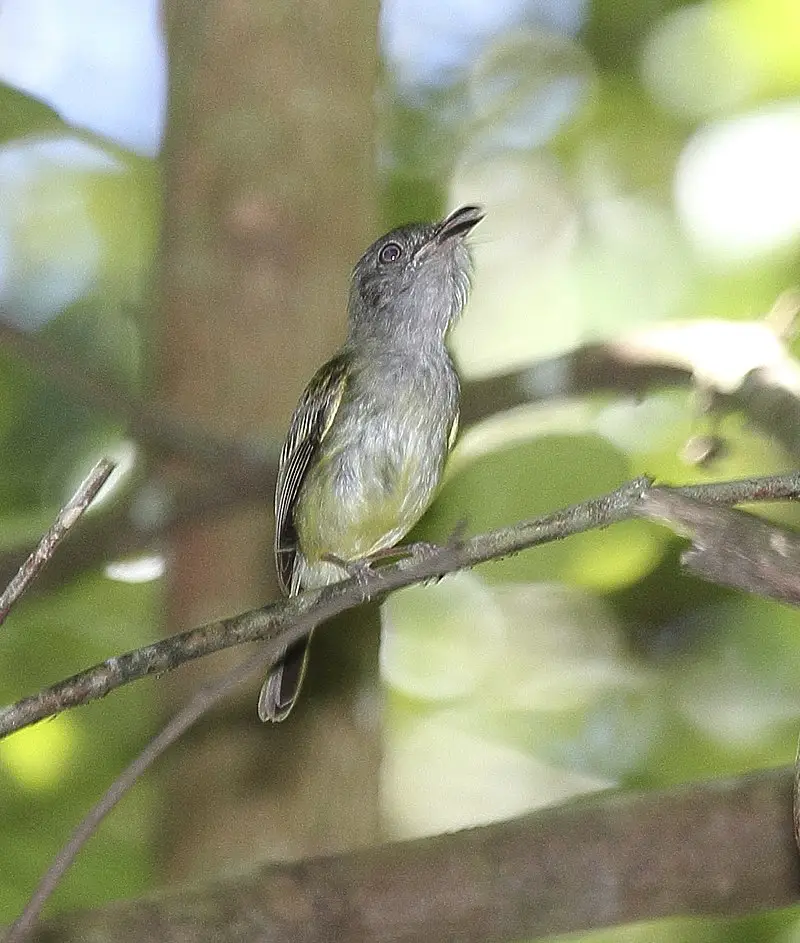
The Northern bentbill is a bird belonging to the Tyrannidae family. This species is native to several regions including Honduras, Guatemala, Belize, and Panama.
It inhabits a variety of habitats including subtropical or tropical dry forests, moist lowland forests, and areas that were once heavily forested.
Despite the degradation of their natural habitat, Northern bentbills continue to thrive.
Their most distinctive feature is their bent bill which enables them to catch insects in flight with great accuracy.
These birds are not very big and have greyish colored feathers with white markings on their throats.
The Northern bentbill is an interesting bird for anyone who enjoys observing birds in their natural habitat.Scientific classification:
| Kingdom | Animalia |
| Phylum | Chordata |
| Class | Aves |
| Order | Passeriformes |
| Family | Tyrannidae |
| Genus | Oncostoma |
| Species | O. cinereigulare |
33. Rose-Bellied Bunting
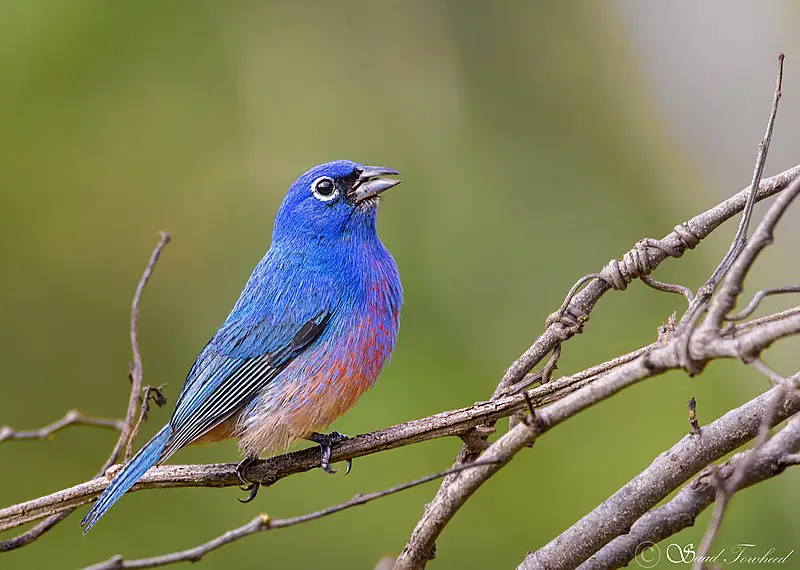
The Rose-bellied bunting, also known as Rosita’s bunting, is a small bird that belongs to the Cardinalidae family. It can only be found in a limited region of southern Mexico, making it a special and unique species.
This bird is the only member of its genus and can be identified by its purplish crown and signature rose-colored belly.
Adult males are 13.5 to 14.5 cm long and approximately weigh 19.5 to 20.5 g, which is relatively light for its size.
The bird has a remarkable appearance with its striking coloring, making it a favorite amongst bird watchers.
Due to its limited range, this bird is classified as threatened, and conservation efforts are underway to ensure its preservation for generations to come.Scientific classification:
| Kingdom | Animalia |
| Phylum | Chordata |
| Class | Aves |
| Order | Passeriformes |
| Family | Cardinalidae |
| Genus | Passerina |
| Species | P. rositae |
34. Yellow-Winged Tanager
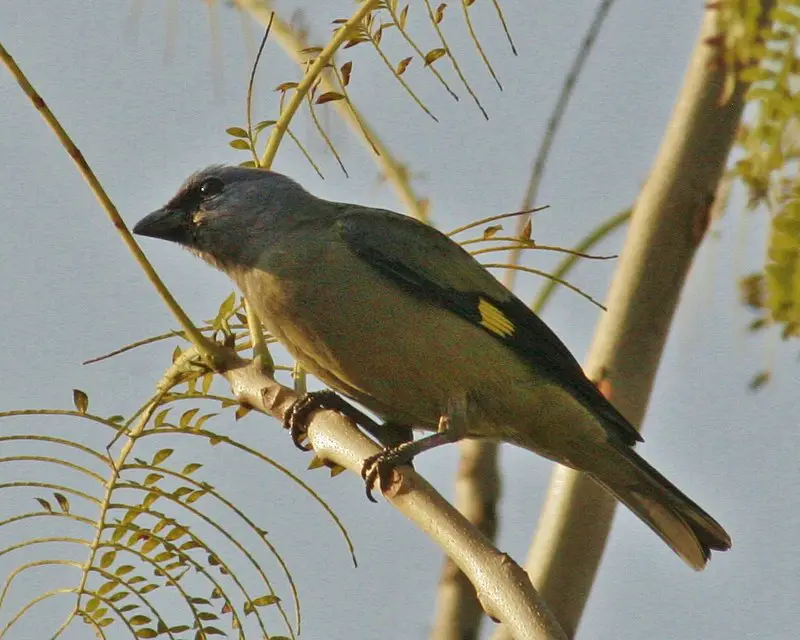
The Yellow-winged tanager is a species of neotropical tanager that’s around 18cm in length. They have a bluish and gray body with yellow patches on their green wings.
Their throat and breast have a pale lavender tone that distinguishes them from other tanagers. The juvenile Yellow-winged tanager is olive-green and lacks the colorful throat and breast.
These birds are often found in forest edges, clearings, and gardens in tropical and subtropical South America. They mainly eat fruits but will also consume insects and seeds.
The Yellow-winged tanager has a unique song that consists of a repeated “chwip” sound.
These birds can often be seen in pairs or small groups and are known to be social creatures.
Overall, the Yellow-winged tanager is a beautiful and fascinating bird that’s worth observing in the wild.Scientific classification:
| Kingdom | Animalia |
| Phylum | Chordata |
| Class | Aves |
| Order | Passeriformes |
| Family | Thraupidae |
| Genus | Thraupis |
| Species | T. abbas |
35. Lesser Roadrunner
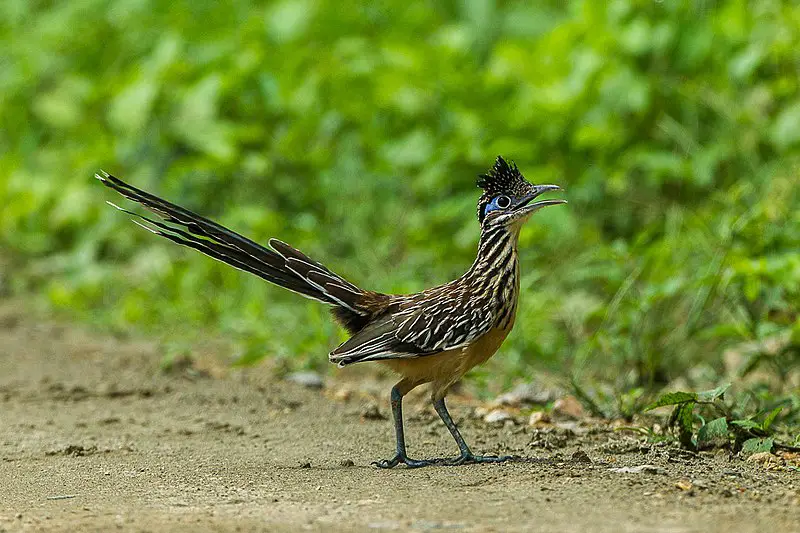
The Lesser Roadrunner bird is a member of the cuckoo family, measuring up to 51 cm long with a tail length of about 24 cm. The bird is slender and has long legs, earning it the Latin name “swift earth-cuckoo”.
Found in Mesoamerica, it is one of two species in the genus Geococcyx, the other being the Greater Roadrunner.
The Lesser Roadrunner is known for its swift movements and is an excellent runner, running at a speed of 24 km/h.
The bird has a pale brown body with dark stripes, making it well camouflaged in its habitat. It primarily feeds on insects, small reptiles, and rodents.
Despite its name, the Lesser Roadrunner is by no means “lesser” in its abilities and provides an important ecological role in its ecosystem as a predator and seed-disperser.Scientific classification:
| Kingdom | Animalia |
| Phylum | Chordata |
| Class | Aves |
| Order | Cuculiformes |
| Family | Cuculidae |
| Genus | Geococcyx |
| Species | G. velox |
Also Featured In: Common Birds of Guerrero, Most Common Birds Found in Nayarit
36. Rufous-Collared Thrush
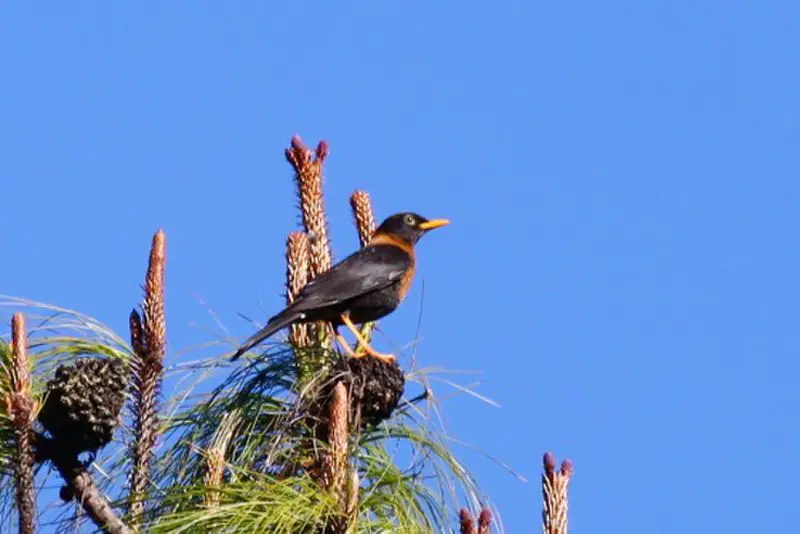
The Rufous-collared thrush is a unique bird species belonging to the Turdidae family. It can only be found in the highlands of Middle America, specifically in El Salvador, Guatemala, Honduras, and Chiapas state in Mexico.
This bird has a close relative, the American robin, and is adaptable to varying habitats such as towns and forests.
However, its presence is limited to these areas. The Rufous-collared thrush has a distinctive appearance, with a rufous collar and black feathers.
It is known for its beautiful song and is a delight to watch in the wild. The bird’s habitats are threatened by human activities such as deforestation, but conservation efforts are being made to ensure its survival.
Overall, the Rufous-collared thrush is a fascinating bird with a crucial role in the ecosystems it inhabits.Scientific classification:
| Kingdom | Animalia |
| Phylum | Chordata |
| Class | Aves |
| Order | Passeriformes |
| Family | Turdidae |
| Genus | Turdus |
| Species | T. rufitorques |